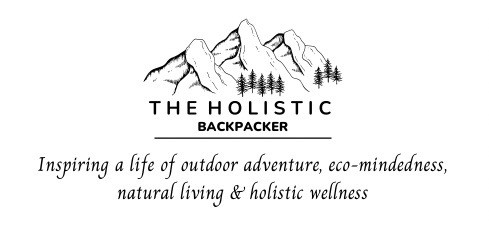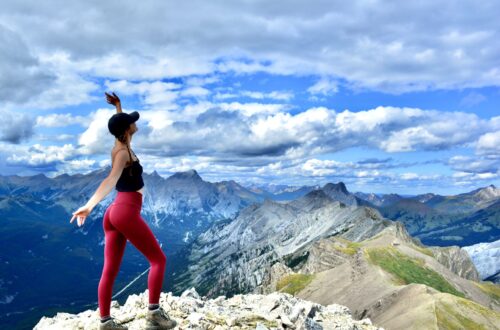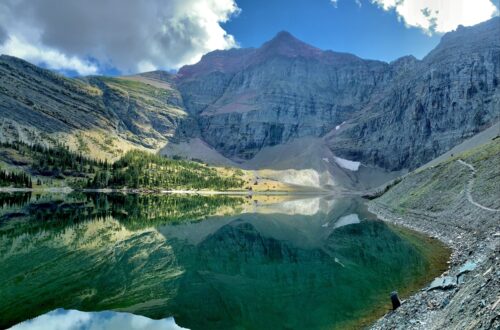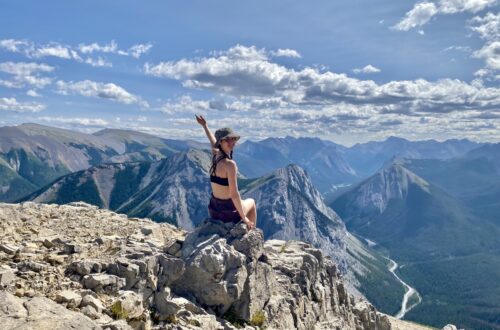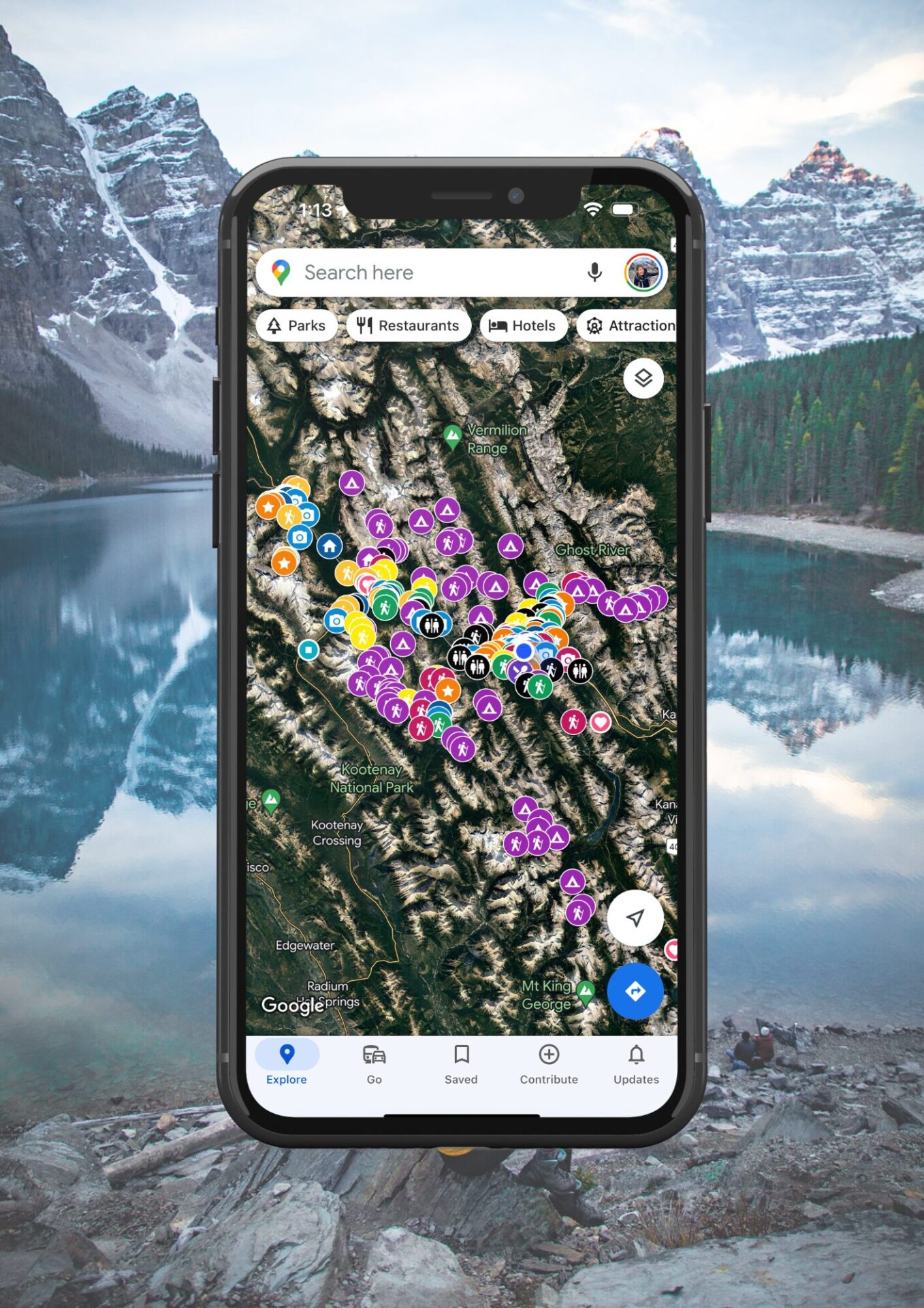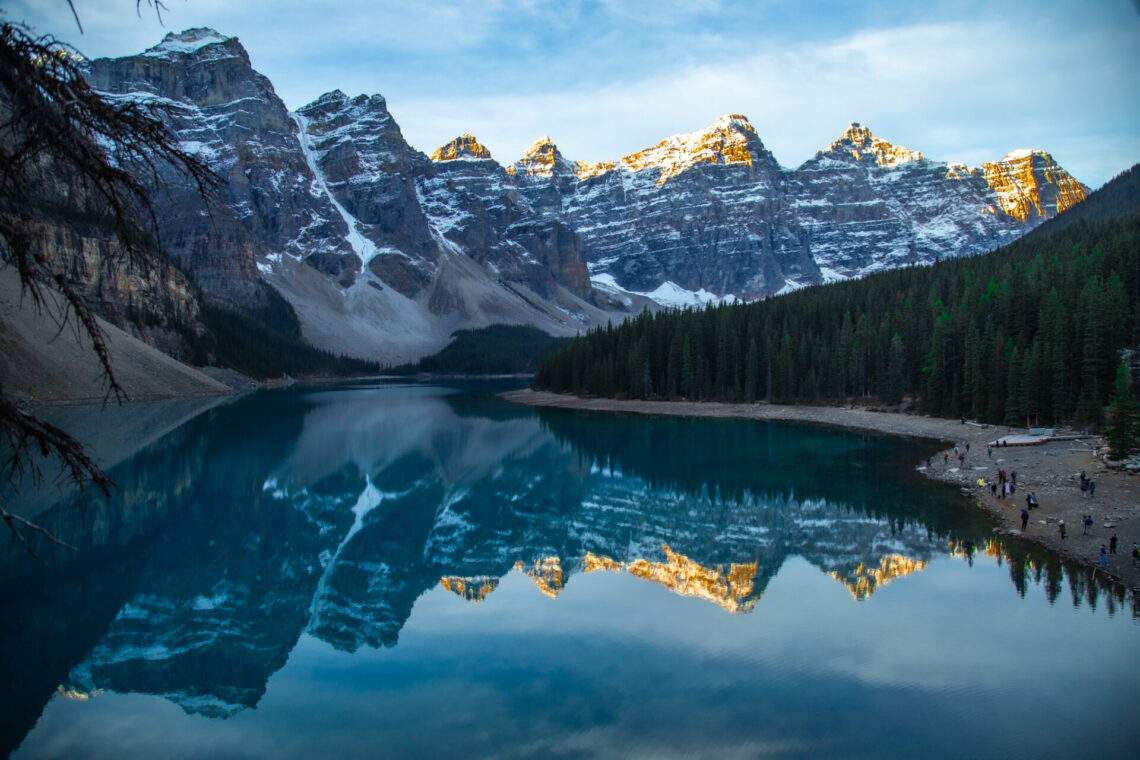
How to Get to Moraine Lake & Lake Louise in 2024 – Hike, Bike, & Shuttles
2023 is the first year in history Moraine Lake road is closed to personal vehicles. So, how the heck do you get to Moraine Lake in 2023 with these new restrictions?
The answer is – it’s complicated. Especially if you don’t have a car. Rest assured, there ARE ways you can get to Moraine Lake despite the closure and in this post I’ll outline all the options for you plus give you some insight as to why these new Moraine Lake road restrictions are in place.
Skip Ahead:
- Where is Moraine Lake
- Why is the Moraine Lake road closed?
- Things to do at Moraine Lake
- Where to stay at Moraine Lake & Lake Louise
- How to get to Lake Louise
- 6 Ways to get to Moraine Lake
- FAQ getting to Moraine Lake
As you read this post, please consider clicking the links throughout. These are affiliate links which means when you book a hotel or purchase a product, I make a small commission at no additional cost to you (full disclosure). These commissions fund The Holistic Backpacker and help me write more blog posts.
Thank you for supporting my work!
Downloadable Banff Map
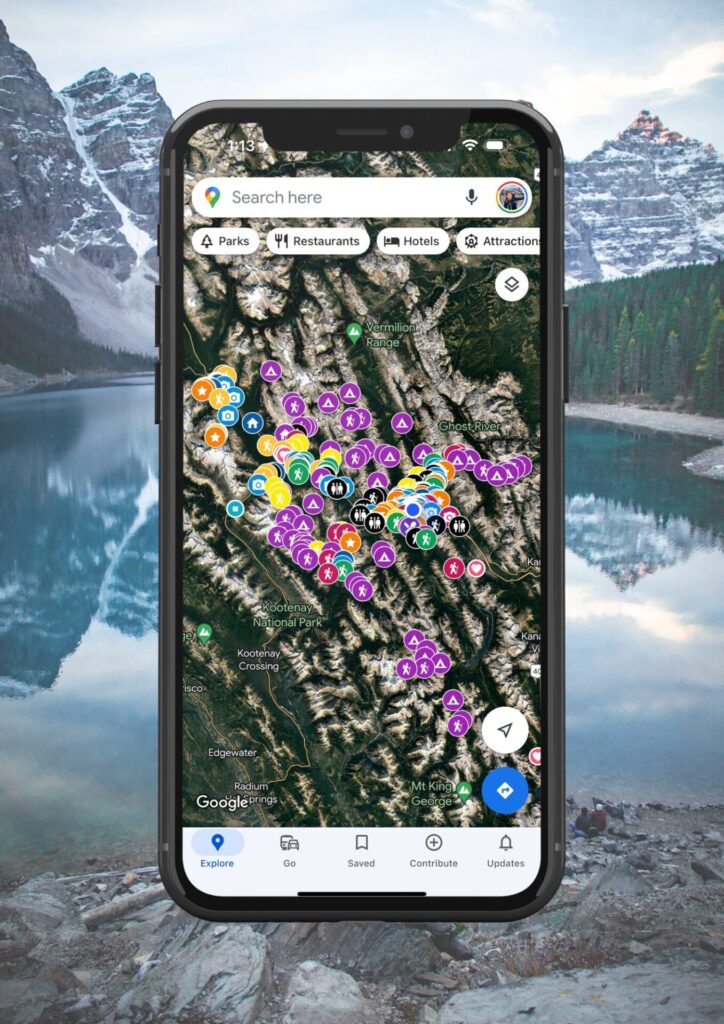
I’ve lived in Banff for years and I’ve now compiled everything I know about the park in this 600+ pin map which I made to help you explore Banff like a local.
The map outlines:
- 100+ hiking trails and backcountry campgrounds
- Every hotel, cabin, and restaurant in the park with ratings, reviews, and booking links
- Unique activities, photo-ops, and blue alpine lakes
- Transit hubs, planning resources, and parking maps
plus plenty of local hidden gems & insider travel tips!
Each pin comes equipped with photos, a description, booking links, and complete guides – designed with the intention of minimizing pre-travel research before your next trip to Banff.
Quick Banff Guide
Parks Pass: You will need a National Park Pass for each day you’re in Banff. Passes can be purchased at the East Parks Gates, the Visitor Centre, any of the campgrounds, or online. If you’ll be in any of Canada’s National Parks for more than 7 days in a 365 day period, an annual Discovery Pass offers a better rate than purchasing individual day passes.
How to get to Banff: fly into Calgary International Airport. From here, rent a car, RV, or take one of the following shuttles to Banff:
- Budget: On-It runs during the summer months and Pop-a-Ride is a ride-share program. You can use my Poparide link to save $5 on your first trip.
- Top private shuttles: Banff Airporter and Brewster.
- Car rental: having access to a car is the best way to travel to/from/within Banff. Here are the best budget car rental options for Canada.
Roam Transit: once you arrive in Banff, use the local transit service as much as possible. There are bus lines within town, plus lines to popular spots like Lake Louise and Johnston Canyon. The bus to Lake Louise should be reserved in advance.
Parking: the best spot to park is the free lot next to the train station. More information about parking in town can be found here and parking fees can be paid here. Bylaw is strict, so ensure you’re following parking rules exactly.
Lodging & Camping: Here’s my guide for hotels in Banff (Organized by Category). If you’re visiting during peak summer (mid June to early September), make your lodging reservations FAR in advance. Front country and backcountry camping reservations must be made on the Parks Canada reservation system. The system typically opens in February and it’s recommended you make reservations then.
Reservations: for activities and restaurants should be made well in advance during summer. Get Your Guide and Viator are popular tour booking platforms whereas OpenTable is used for restaurants.
When to visit: Hiking – July to mid September. Backcountry camping, wildflowers, & water activities – July to August. Fall colours – mid September to early October. Wild ice skating – usually early December. Skiing (best snow), coldest temps & frozen waterfalls – January & February. Northern lights – December to February. Best spring skiing – March to April. Quietest months to visit – April, May, October, and November.
Visiting Moraine Lake or Lake Louise? Read my guide for how to get there with the new road closures. If you want to see Moraine Lake at sunrise, you can book a shuttle here.
Wildlife Safety: 11 ways to stay safe from wildlife, bear safety, & bear basics.
General Canada Travel Tips
Travel Insurance: ALWAYS purchase reliable travel insurance before your trip. This insurance is trusted by backpackers and adventure sport enthusiasts around the world. You can also use my link to receive 5% off SafetyWing policies. Here’s a blog post with more trustworthy travel insurance options you can compare.
Public transit is not common in North America, however every big city has their own local transit system. If you want to venture out of big cities or to any natural spot, plan to rent a car – here are the best budget car rental options in Canada. Trains (Via Rail) are not well connected within the country and are expensive. Hitchhiking is relatively uncommon here, however Poparide is becoming more popular for ride sharing.
Phone: popular providers are Rogers, Telus, and Koodoo. SIM cards can be purchased at the airport, phone stands, or provider storefronts. Canada has some of the most globally expensive phone rates.
Language: English & French (in Quebec).
Currency: Canadian dollars – displayed as “$” or “CAD”. Both cash and card are accepted everywhere.
Visas are typically not needed for stays up to 6 months in Canada.
Tipping culture: You are expected to tip 15-20% minimum on every meal. You are also expected to tip drivers, hair dressers, or anyone providing a “service” to you.
Tax: is not included in the price you see. Each province has their own tax bracket – Alberta 5%, Ontario 13%, British Columbia 12%, etc.
Helpful Banff Blog Posts
- 25+ Epic Lake Louise Hikes
- Step-by-step guide for planning a trip to Banff
- Best Hotels in Banff – Organized by Category
- How to get to Moraine Lake & Lake Louise
- 50+ Things to do in Banff in summer
- 30+ Epic things to do in Banff in winter
- Complete guide to the Icefields Parkway
- 12 Easy Hikes in Banff
How to get to Moraine Lake
Where are Moraine Lake & Lake Louise?
Moraine Lake and Lake Louise are located just outside the town of Lake Louise which is a 45 minute drive from the town of Banff.
Moraine Lake and Lake Louise are 2.5hrs from Calgary, 1.5hrs from Golden and they’re both reachable by bus if you’re coming from the town of Banff or Lake Louise Village.
Skip ahead: How to get to Moraine Lake
Why is the Moraine Lake Road Closed?
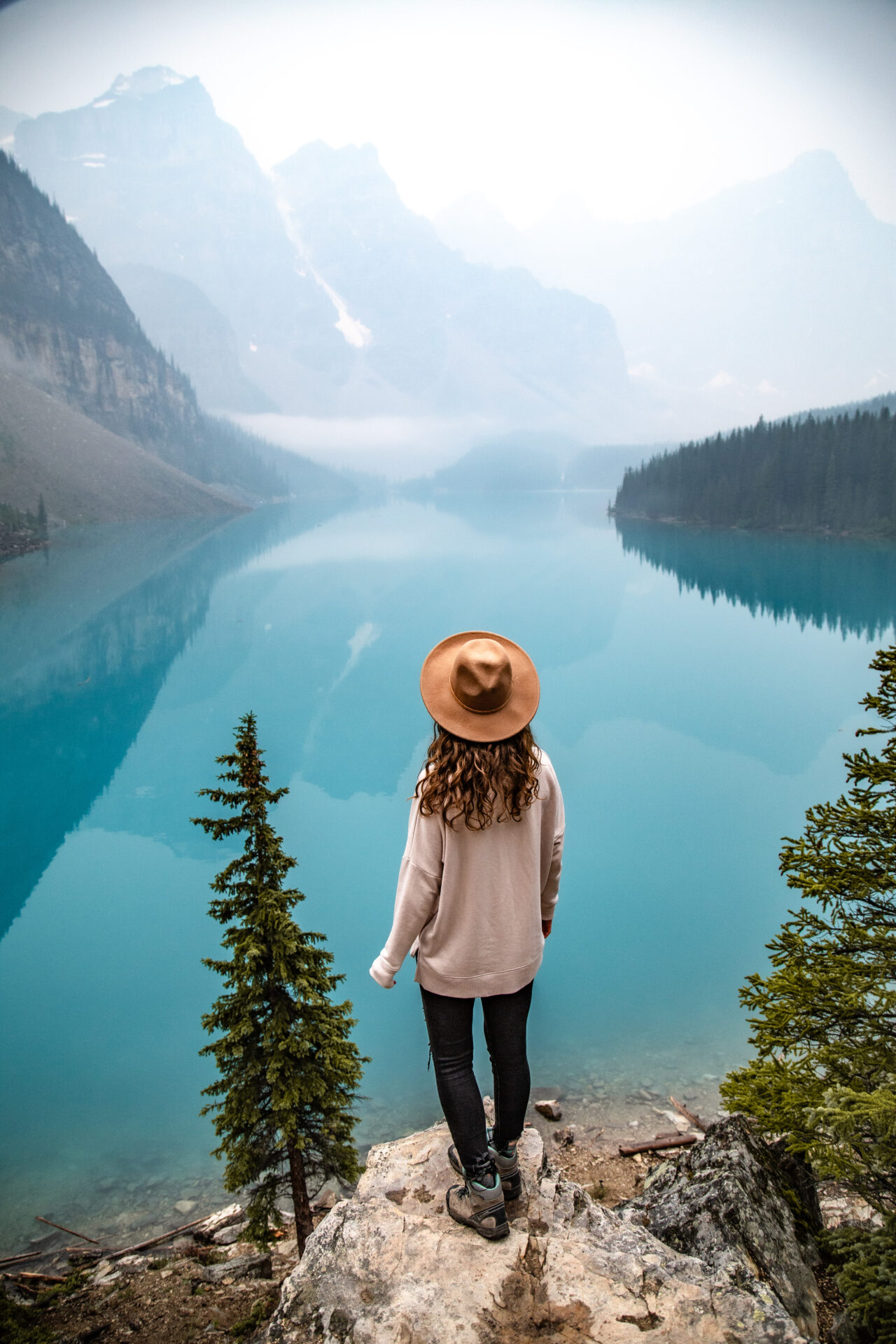
Moraine Lake is the “poster-child” of Canadian nature and beautiful mountain scenery. If you’ve seen anything online about Canada prior to visiting, it’s either been photos of Moraine Lake and/or Lake Louise.
Moraine Lake is the bluest body of water I’ve ever seen + the way it’s positioned makes for the most unreal sunrise. The alpenglow from the rising sun completely lights up the Valley of the Ten Peaks which are the beautiful mountains backing the lake. These factors plus the beautiful hiking trails and Larch trees in the fall make Moraine Lake #1 on anyone’s Canada bucket list.
With this being said, Moraine Lake was becoming a bit chaotic. If you wanted a parking spot you’d have to arrive no later than 4:00am and even that was becoming “too late.” The vast number of people visiting the lake was putting the fragile ecosystem there at risk & the environment around the lake was becoming much too touristy in terms of noise pollution, garbage, etc.
The Moraine Lake road closure was put in place to protect the vegetation, landscape, and wildlife in the area. Even though it’s much more difficult to get to Moraine Lake come 2023, I’m so grateful the road has been closed for preservation purposes.
Skip ahead – how to get to Moraine Lake.
Things to do at Moraine Lake & Lake Louise
Moraine Lake and Lake Louise are paradise for outdoor adventurers. The hiking trails, mountain tops, and blue bodies of water in the area make for an ethereal landscape. Here are a few things you can do at Moraine Lake and Lake Louise:
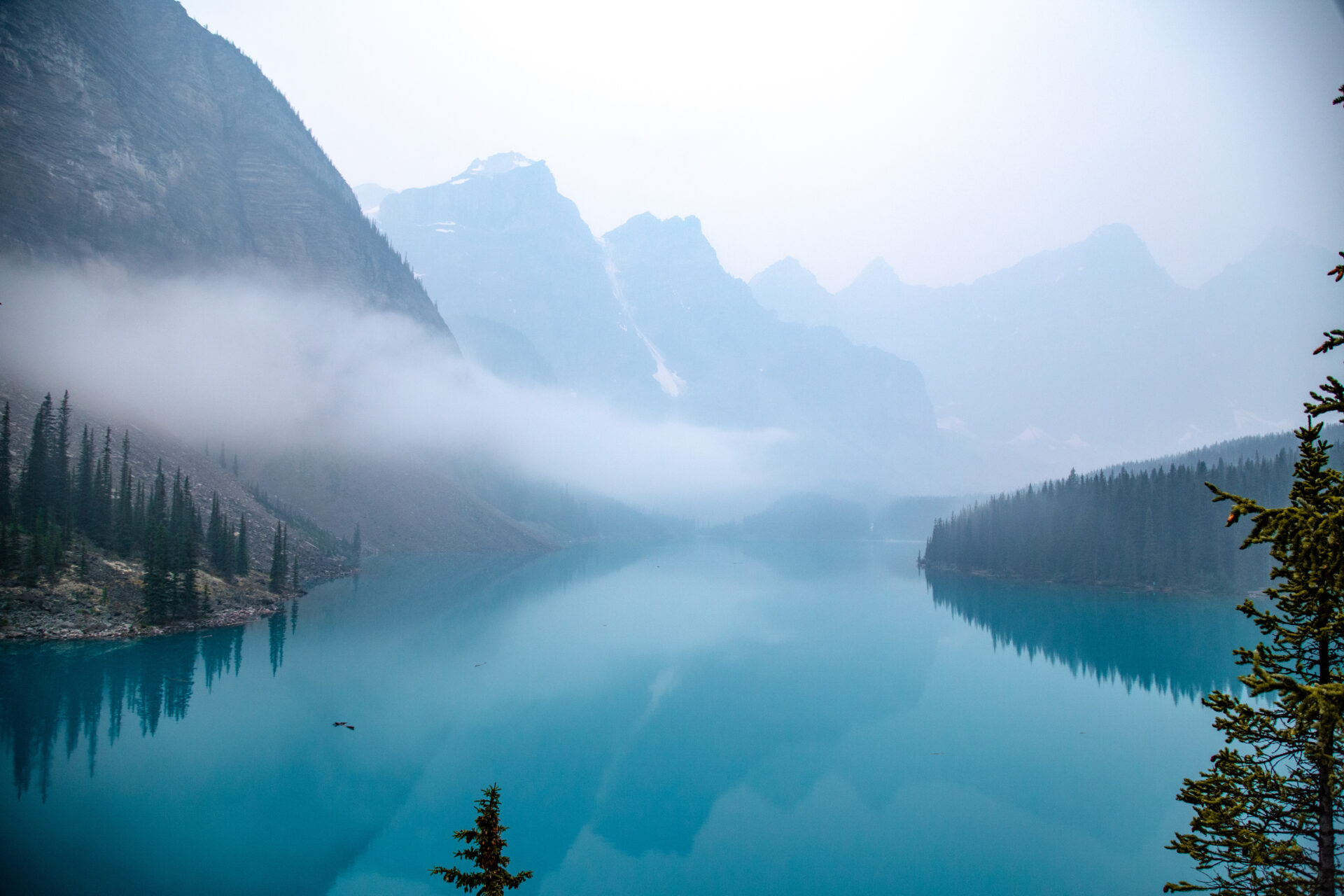
- Go hiking – my favourite trails in the area are Tower of Babel, Larch Valley + Sentinel Pass, Consolation Lakes, and Mount St Piran.
- Watch sunrise – Moraine Lake and Lake Louise are two of the most beautiful sunrise locations in Canada. As of 2023 the only way to see Moraine at sunrise is to take a private bus operator, which you can do here.
- Canoe – canoes can be rented from the docks at the lakes. Last I checked rentals were upwards of $150/hour but the experience is definitely worth the price tag.
- Stay at the Moraine Lake Lodge – this is a pricey endeavour, but the lodge gives you unlimited access to the lake, hiking trails, and canoe rentals. Your food and parking are included (you can drive a personal vehicle if you stay at the lodge), but make sure you book far in advance as rooms here fill up instantaneously when bookings go live.
- Stay at the Fairmont Chateau Lake Louise – get a front row seat to one of the most beautiful lakes in Canada. Discounted canoe rentals are included in your stay, on-site dining is available, and you won’t have to fight the crowds to find parking.
How to get to Moraine Lake
Top Tours & Excursions in Banff
Banff Gondola – epic views from the top of Sulphur Mountain.
Banff Hop on Hop off – explore the park at your own pace.
Lake Minnewanka Cruise – take a scenic boat ride down the largest lake in Banff.
Moraine Lake sunrise – chartered bus to see alpenglow on Canada’s most beautiful lake.
Norquay via ferrata – epic beginner friendly climbing route across iron bars on Mt Norquay.
Sunshine Meadows Gondola – find wild alpine flowers and hike around pristine alpine lakes.
Moraine Lake sunrise
Where to Stay at Moraine Lake and Lake Louise
There are plenty of places to stay in the lake Louise area. You can find a list of all Lake Louise accommodations here, but the following are my favourite:
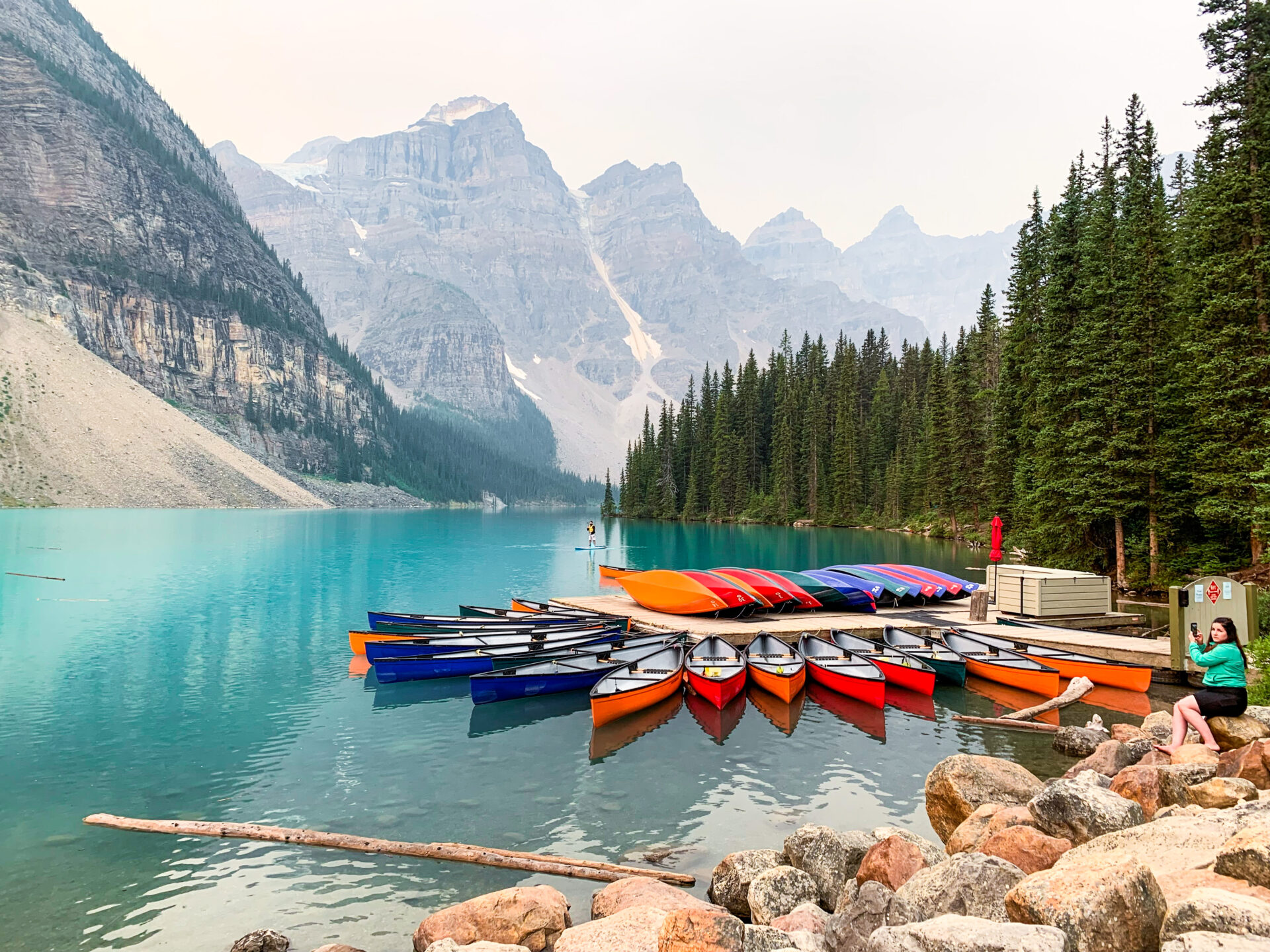
Moraine Lake
The only place to stay at Moraine Lake is the Moraine Lake Lodge. If you want to stay on the lake, be sure to make a reservation far in advance as bookings fill up instantly. Staying at the lodge grants you unlimited access to the lake, canoe rentals, a parking spot (lodgers can drive their personal vehicles to Moraine Lake), and food.
Lake Louise
- Fairmont Chateau Lake Louise – this is a bucket list stay in the Canadian Rockies! The Fairmont is located on the edge of Lake Louise. The view from the hotel widows are amazing and guests at the Fairmont are the only people eligible to use the complimentary canoe rentals at sunrise.
- Paradise Lodge and Bungalows is only 500m away from the lake and it’s a more budget-friendly option than the Fairmont.
- HI Lake Louise Hostel – for the backpacker looking to save a few $ and meet people along the way. Book in advance (Jan/Feb) as the hostel fills up early in the year.
- Local Campgrounds – run and maintained by Parks Canada. These campgrounds are the ultimate budget option in Lake Louise, but you must book months in advance if you want a spot during high season.
- Lake Louise Inn – best value stay in town.
How to get to Lake Louise
Out of the two, Lake Louise is much easier to access than Moraine Lake. Here are the options for getting to Lake Louise:

Drive Your Personal Vehicle to Lake Louise
Unlike Moraine Lake, you CAN drive to Lake Louise. The Lake Louise parking fee is now a whopping $36.75 per day (as of 2024). You must arrive early to get a parking spot – no later than 7:00am. Earlier on weekends, holidays, or high season just to be sure. Keep in mind, parking is guaranteed to fill up every day.
If the parking lot at Lake Louise is full, you can park your car at the Lake Louise ski resort (for free) and take the Park & Ride shuttle (for a fee) to the lake. It’s recommended that you book your shuttle in advance as they typically sell out, however walk ons are accepted according to availability. Cash is required for payment for walk ons – $8 per person.
To make a booking: click this link, filter the menu to “day use” -> choose the “Moraine Lake & Lake Louise” option -> select “Banff – Lake Louise” as the location -> filter your dates -> click the “list” icon & choose a time.
Alternatively, the Moraine Lake Bus company offers a direct route to Lake Louise from the town of Banff which alleviates the hassle of “planes, trains, and buses.”

Bus to Lake Louise – Roam Transit Routes
Special note for the bus to Lake Louise – the Lake Louise bus runs year-round. Make reservations in advance when possible. Seats on these buses are booked far in advance and spots are limited. If there are no reservable spots online, arrive at the bus stop at least 1hr before the bus departure to try to get a walk-on spot. Have exact cash ready or pay using the ‘Token Transit’ app.
Return reservations can also be made, but typically there’s lots of space on the return shuttles and you can walk on whenever. I’ve used the return bus service multiple times and have never been denied access.
- Route 8X – this bus line departs the high school transit hub (across IGA) in the town of Banff and goes directly to the lake. It’s best to get a day pass (round-trip fare) which is $20 for adults, $10 for youth + senior, and free for children 12 and under.
- Route 8S – this route also departs from the transit hub in Banff, but takes the scenic highway 1A to Lake Louise rather than the Trans Canada. The cost is the same as the 8X and there are various stops along the 1A. This is a great option for car-less hikers who are looking to explore different trails along the 1A. This service is suspended for the 2024 season.
SUPERPASS
This pass is the holy grail of bus passes in Banff. It’s a one-day pass which grants you unlimited access to the 8X and 8S as well as the Moraine Lake connector, Canmore/Banff regional, Johnston Canyon route and more. I recommend this pass if you’re hoping to visit both lakes or multiple locations within the Bow Valley in the same day.
The pass costs $25/adults, $12.50 for youth + seniors, and free for children 12 and under. Reserve your Superpass here.
How to Pay for the Roam Bus
As previously mentioned, the Roam bus is the local bus in Banff. It’s the easiest method of accessing Moraine Lake and Lake Louise.
No cards are accepted for payment on the bus, so you must have exact change or pay via the Token Transit app. The app is my preferred method of payment.
7 Ways to get to Moraine Lake
The Moraine Lake bus is only operational during the summer months as the road is not maintained once the snow hits. The road is typically open from June 1-Oct 10, but this is weather dependent.
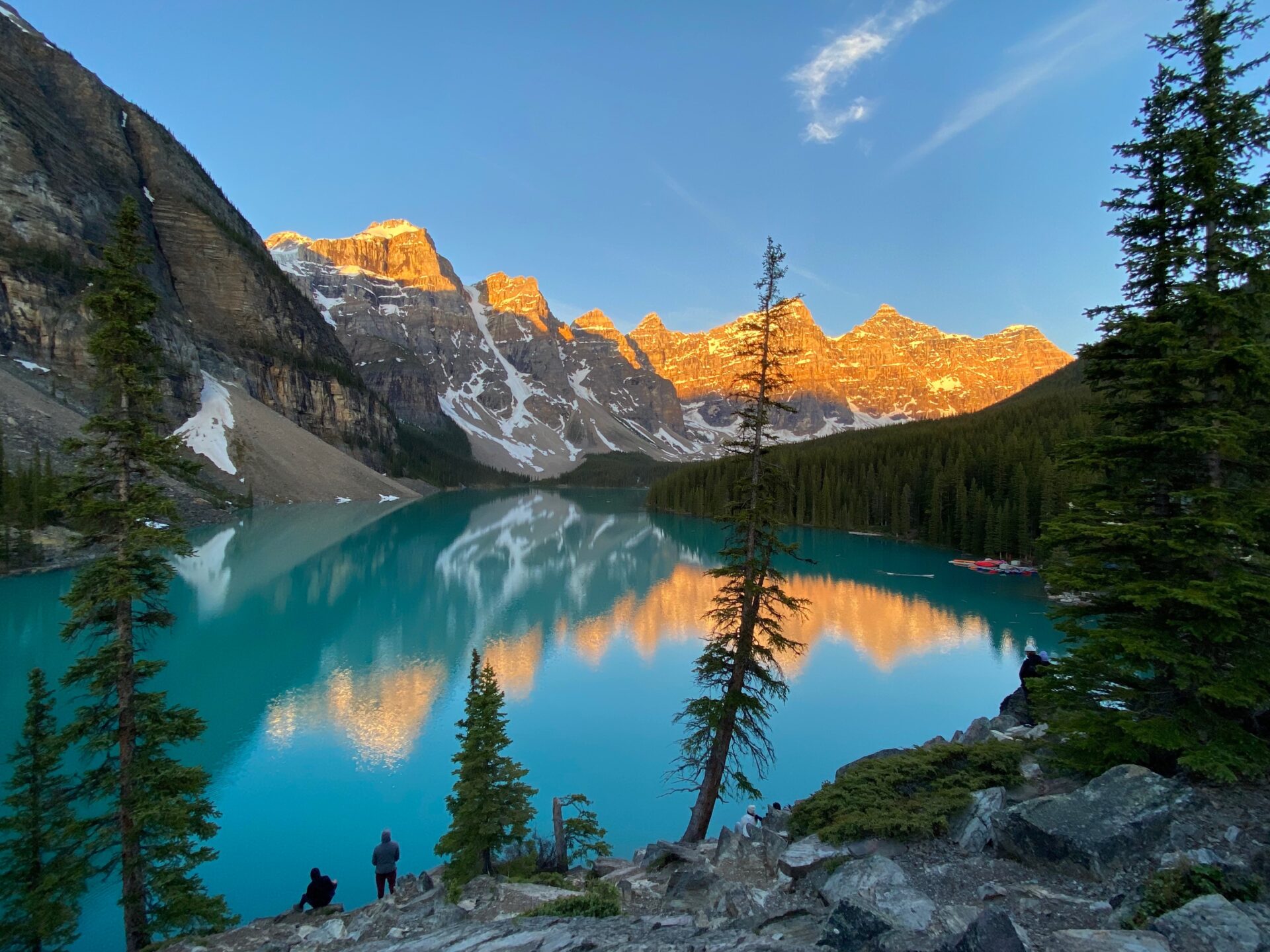
1. Public Transit to Moraine Lake
Using public transit to get to Moraine Lake is complicated – I’ll try to break things down as simply as possible here:
- If you have a car
- Drive to the Lake Louise ski resort for the Park and Ride program. The Parks Canada shuttle will take you directly to Moraine Lake. On the return you will be dropped off at Lake Louise Lakeshore where you’ll catch the free shuttle back to the Ski Resort.
- Use the Parks Canada Reservation Service to book your round-trip connector bus to Moraine Lake.
- How to book the Moraine Lake connector: filter the menu to “day use” -> choose the “Moraine Lake & Lake Louise option” -> select “Banff – Lake Louise” as the location -> filter your dates -> click the “list” icon & choose a time.
- If you don’t have a car – book a Superpass. This will provide you with transportation from the town of Banff to Lake Louise AND Moraine Lake.
- From the Highschool Transit Hub in Banff go to Lake Louise Lakeshore. Catch the Parks Canada shuttle to Moraine Lake from here, then catch the same connector back to lake Louise where you’ll hop back on the Roam bus back to Banff.
- Note – the Parks Canada shuttles to and from Moraine Lake are plentiful and run constantly. Don’t worry about timing.
- With the superpass you’ll also have 24hr access to all Roam transit services; Canmore, Johnston Canyon, Sulphur Mountain, Lake Minnewanka, etc
**Reservations online or by phone (1-877-737-3782 OR 1-519-826-5391 for outside North America) must be made FAR in advance. Otherwise, you can try a last-minute reservation. This is an excerpt from the Parks Canada website about last minute reservations:
“Limited spaces will be held for last-minute reservations, and will be released daily at 8:00 a.m. MDT, two days before the scheduled departures. – Tickets are for a one-hour window; you may show up anytime during that hour. Once at the lakes you may stay as long as you choose and connect between Lake Louise and Moraine Lake on a first come first serve basis, via the Lake Connector shuttle. Your ticket includes return shuttle service from either lake back to the Park and Ride.”
More information from Parks Canada
2. Sunrise Shuttle to Moraine Lake
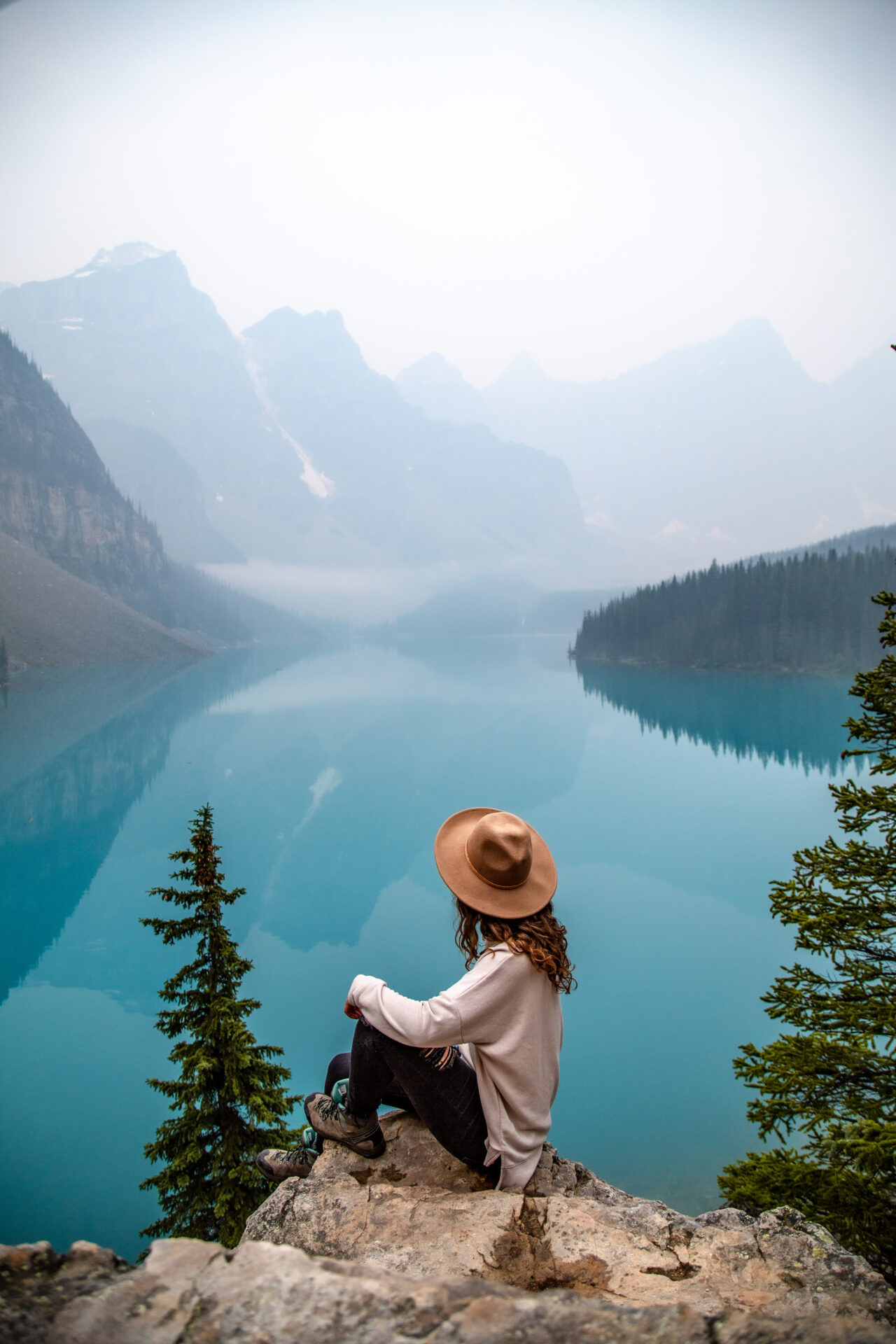
If you’re wondering how to get to Moraine Lake for sunrise, this is it.
The Moraine Lake Bus company is a private bus operator which is owned by two Banff locals. They pay their employees a fair Alberta living wage (a rarity for Banff) and offer various deals to locals throughout the season. The shuttle is very well organized and comfortable, plus their staff is very friendly and knowledgeable.
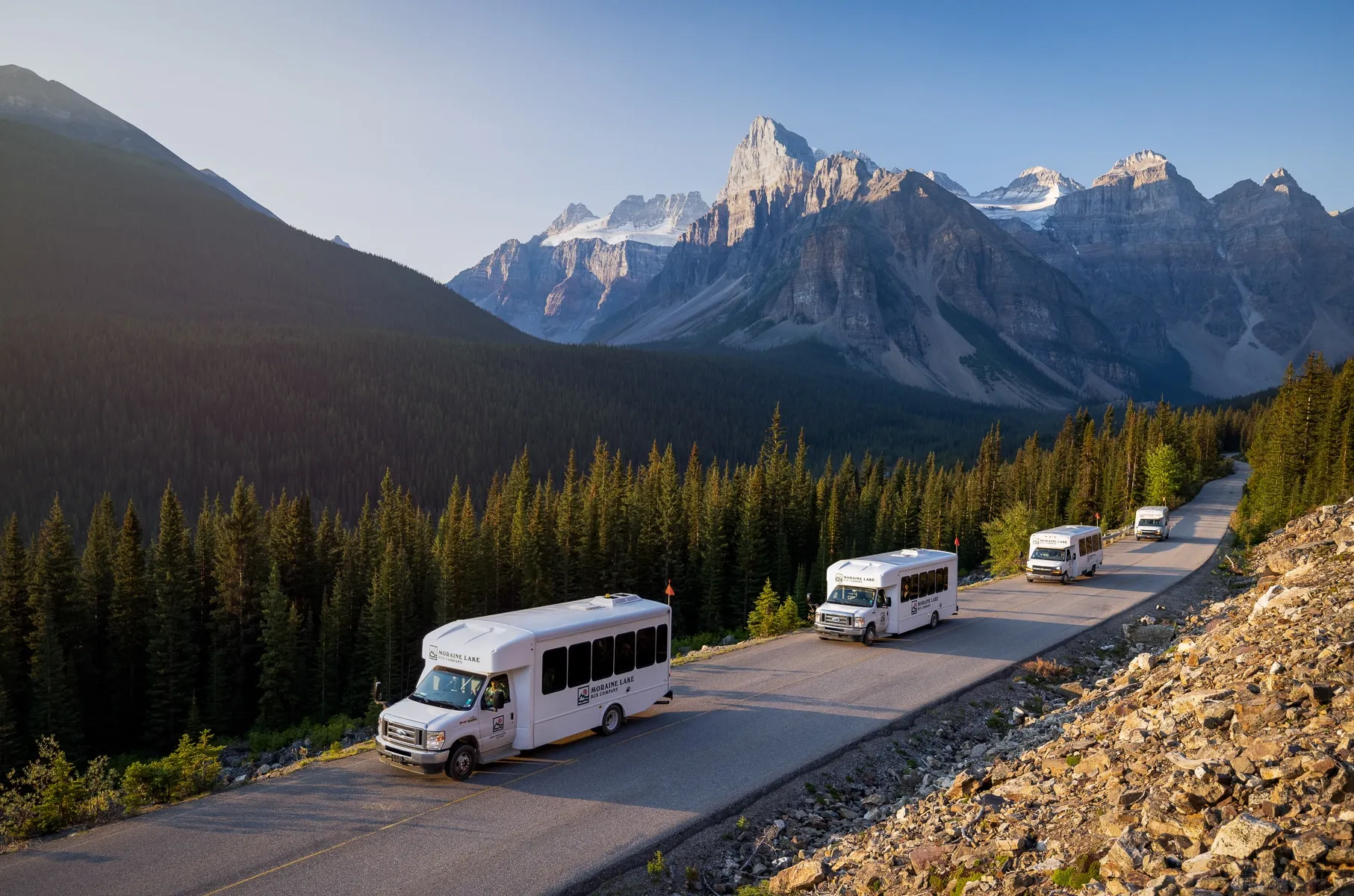
If you’re hoping to get an alpine start for some of the longer hiking routes in the area (like Mount Temple or Eiffel Peak), the sunrise shuttle is the best and only way to get there before the 8am public shuttles arrive.
As of 2024 the Moraine Lake Bus Company has added new services like a direct route to lake Louse from the town of Banff and a daytime route which stops at both lakes.
3. “Alpine Start” via Parks Canada Shuttle to Moraine Lake
As of 2024, Parks Canada has implemented an “alpine start” shuttle for hikers and climbers looking to tackle bigger objectives in the Moraine Lake area. This service books completely in advance, however 2 days before your arrival date at 8:00am, limited last minutes spots can be reserved here.
The alpine start shuttles to Moraine Lake are at 4:00am and 5:00am from Lake Louise Lakeshore. Shuttle fees + Lake Louise parking fees apply.
4. “Hike” to Moraine Lake
You can hike – more like “excruciatingly walk” – to Moraine Lake from the parking lot at the end of the road, but it’s a 26km+ roundtrip journey. I would not recommend this option at all, but I must mention it because it’s one of the few options available to get to Moraine Lake.
5. Bike to Moraine Lake
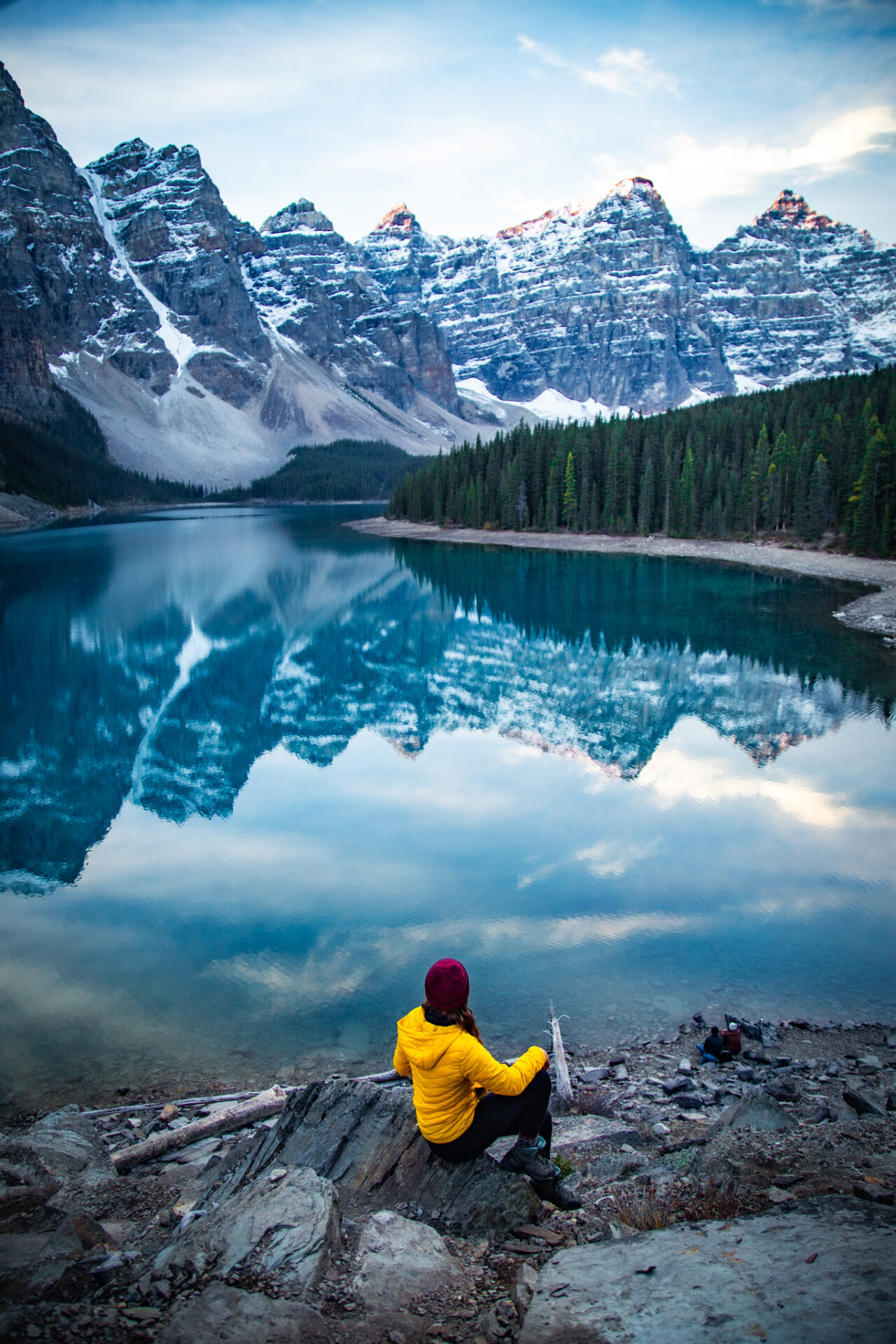
You can also bike up to the lake from the Lake Louise Village. The distance is 30kms+ with 400m+ of elevation gain (around 1.5hrs+ one-way). You’ll pass through grizzly territory on the way to the lake, so this option isn’t great if you’re planning to bike in the early hours of the day or evening hours for safety reasons.
A better option is to rent E-bikes from one of the adventure hubs in the town of Banff or Lake Louise. This will save you lots of time and energy.
How to get to Moraine Lake
6. Stay at Moraine Lake Lodge
Moraine Lake Lodge is situated on the edge Moraine Lake, giving you unlimited access to the lake, local hiking trails, food, and canoe rentals. This is a pricey option, but it’s the best way to authentically experience Moraine Lake!
Make sure to book your stay in advance as spots fill up far in advance.
7. Book a Guided Tour to Moraine Lake
Guided tours are not my favourite – or even preferred – way of travelling because of the amount of people on-board + the rush, BUT if you’re desperately searching for how to get to Moraine Lake, this could be a great option. Guided tours save the hassle of DIY booking and they’ve always got space available.
Both Get Your Guide and Viator have great Moraine Lake transportation options. These hyperlinks will bring you directly to the Moraine Lake tours: Get Your Guide + Viator.
Moraine Lake Autumn Shuttle Service
This is my favourite way to get to Moraine Lake. This option is only available during Larch season.
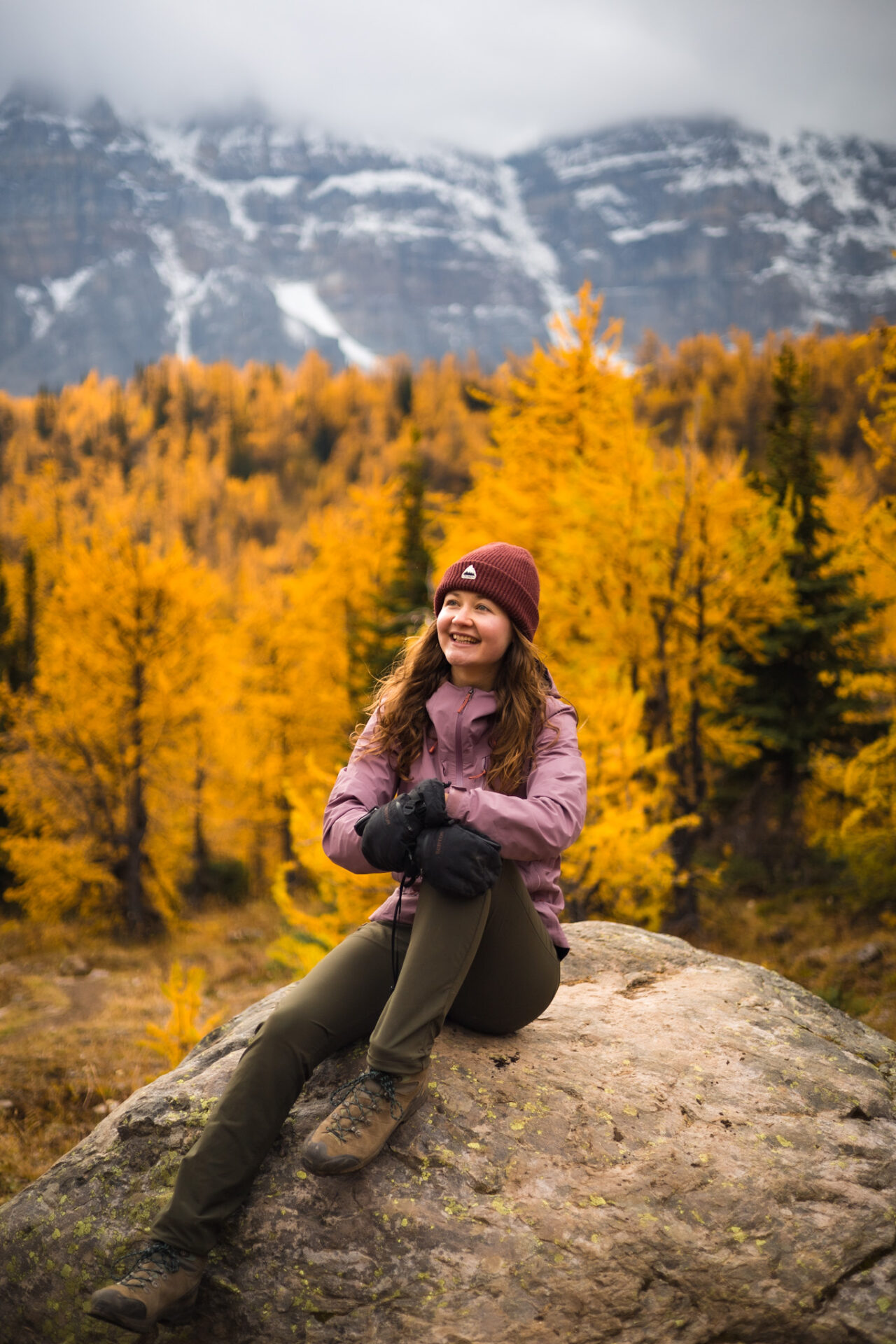
The Moraine Lake fall service typically begins around mid September and goes until the end of the season – aka when the Moraine Lake road closes in October. The closure typically happens around October 10th, but it’s weather dependent. The fall service is route 10. It departs the High School Transit Hub across from IGA and drops you off directly at Moraine Lake.
Once October hits you’re actually able to see sunrise at Moraine Lake via route 10 on the 7:00am bus making this the easiest and best way to get to Moraine Lake for sunrise. For a limited period of time that is.
Reservations are required to use this bus, but walk-ons are accepted if there’s room. Take exact cash ($25) and get to the stop early.
FAQ Getting to Moraine Lake
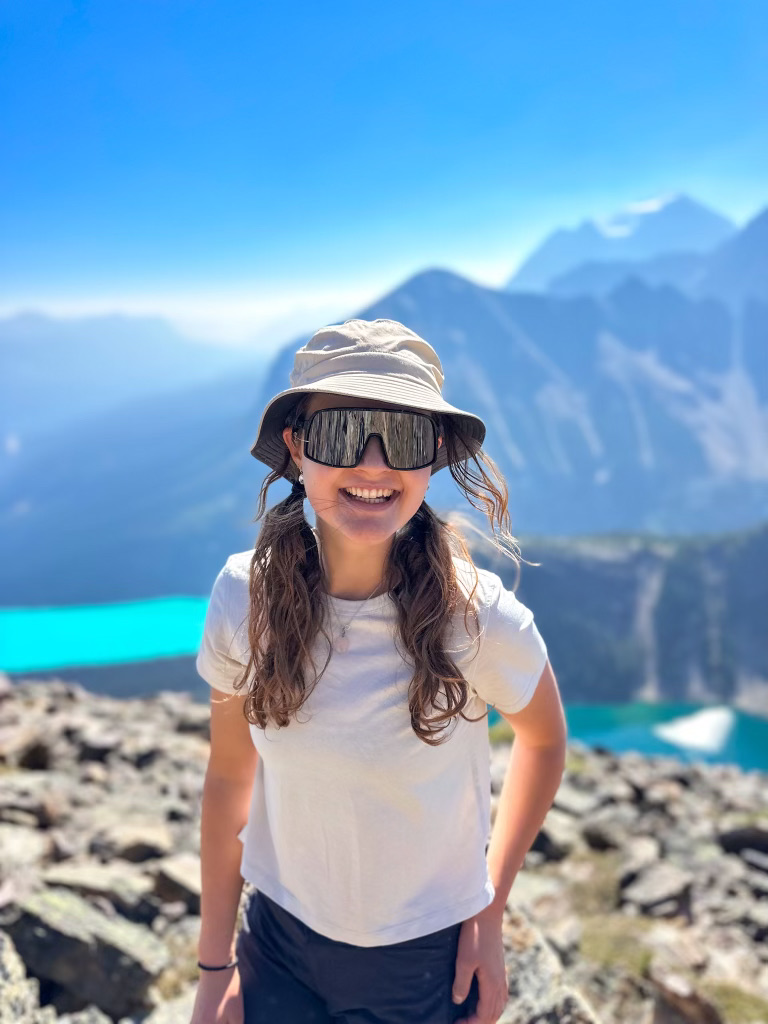
- When is the Moraine Lake road open?
Typically the Moraine Lake road is open from June 1-October 10, but this is weather dependent as the road is not maintained throughout the winter.
- How can I see sunrise at Moraine Lake?
With the new road closures in place, the best way to see sunrise at Moraine Lake is to book a privately operated sunrise shuttle, stay at the Moraine Lake Lodge, or use Parks Canada’s alpine start shuttle.
- Can I bring dogs on the Moraine Lake bus?
Dogs and other animals are not permitted on the Roam bus OR Parks Canada shuttles unless they’re small enough to fit in a lap carrier (Roam) OR crate (Parks Canada).
Private limos and some tour operators offer pet-friendly transportation. You can find more about those options here.
- Can kids ride the bus to Moraine Lake for free?
Children 12 and under can ride the Roam bus and Parks Canada shuttles for free.
- Are there are any discounts available for the Moraine Lake bus?
No “discounts” are available, however youth (13-17) and seniors (65+) can ride the Roam bus & Parks Canada shuttles for half the cost of an adult.
- How far in advance do I need to book the Moraine Lake and Lake Louise shuttle?
As far in advance as possible. Most visitors make their reservations months in advance. Spots are very limited as this is one of Canada’s most popular tourist attractions.
- Is there any way to drive my own car to the lake?
The only way to drive your own car to Moraine Lake is if you stay a night at the Moraine Lake Lodge OR if you have a handicap placard.
- How do I get to Moraine Lake and Lake Louise without a reservations?
You can access Lake Louise without a reservation via driving a personal vehicle to the lake. Be sure to get there latest 7:00am during summer for parking purposes.
If you do not have a personal vehicle, try to get a walk-on spot on the bus to Lake Louise or Moraine Lake. Be at the bus stop early and have exact change to pay for the bus. In high season I arrived 1 hour early before the first bus and I never had issues getting on.
- How do I pay for the Roam bus?
You can pay online when you make a reservation or have exact change; no cards are accepted for payment. Alternatively, you can pay via the Token Transit app. The app is typically my preferred way of paying.
Downloadable Banff Map

I’ve lived in Banff for years and I’ve now compiled everything I know about the park in this 600+ pin map which I made to help you explore Banff like a local.
The map outlines:
- 100+ hiking trails and backcountry campgrounds
- Every hotel, cabin, and restaurant in the park with ratings, reviews, and booking links
- Unique activities, photo-ops, and blue alpine lakes
- Transit hubs, planning resources, and parking maps
plus plenty of local hidden gems & insider travel tips!
Each pin comes equipped with photos, a description, booking links, and complete guides – designed with the intention of minimizing pre-travel research before your next trip to Banff.
and those are all your options for hoe to get to moraine lake and Lake Louise.
Happy adventuring!
Taylor ♡
Like This Post?
Share with friends or save it for later!
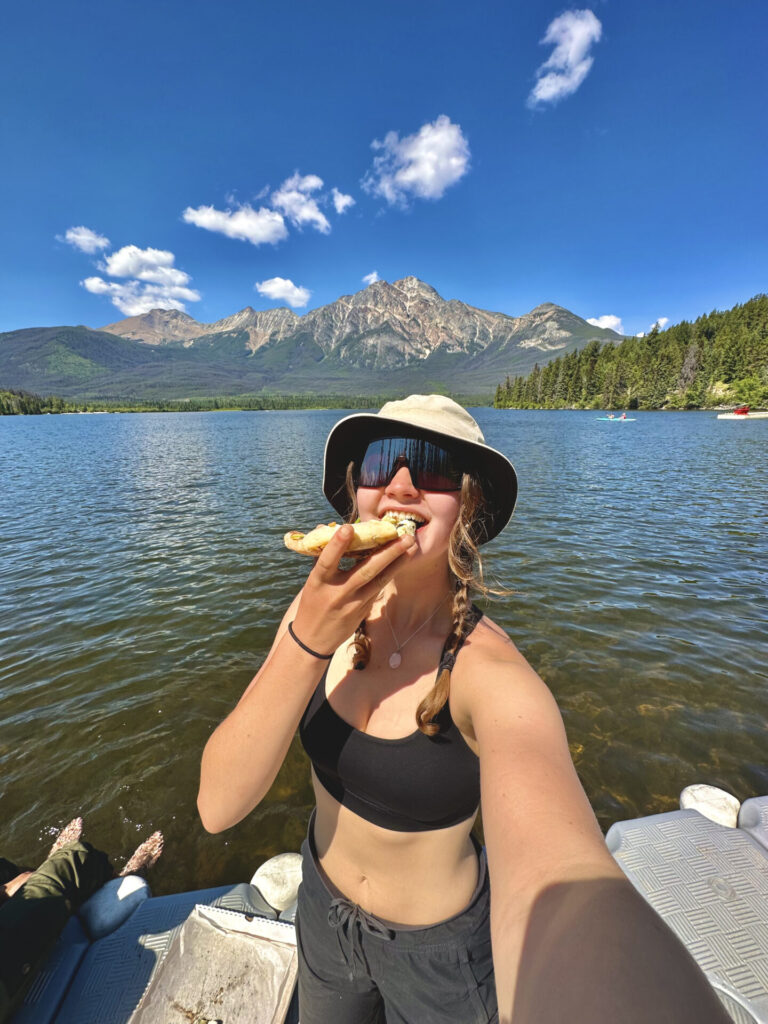
About The Author
HI, I’m Taylor – the voice behind The Holistic Backpacker.
After moving to Banff National Park in 2020 I became an outdoor adventure enthusiast and vowed to never stop exploring.
I now spend my days travelling the world, climbing mountains, and spending nights under the stars in the Canadian Rockies backcountry.
I created The Holistic Backpacker so I could share my adventures and help connect people like you with the same amazing experiences.


